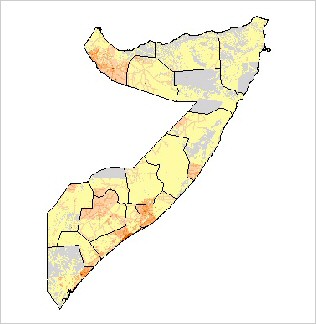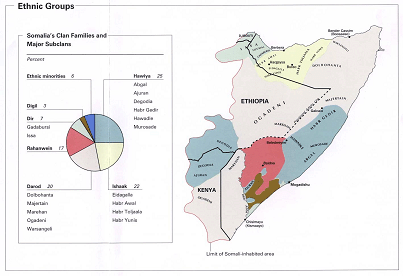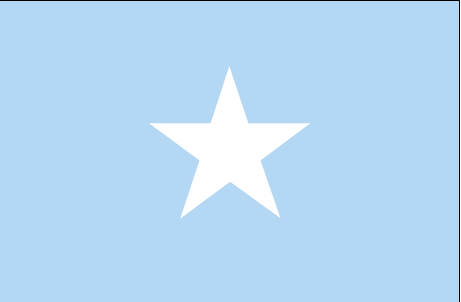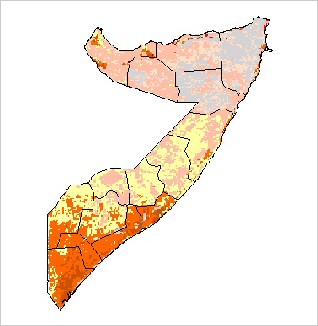|
|
 |
| |
back to top | ||
|
Population: In the 1960s, cheetahs have suffered a very serious depletion in Somaila and disappeared from the more settled areas. More recent sightings report the cheetah in the Caluula, Skushuban and Qardho districts and in the Sidali region. In December 1998, a sleeping cheetah was observed in the area of Sidali. |
|||
|
|
|||
|
|||
|
Britain withdrew from British Somaliland in 1960 in order to allow its protectorate to join with Italian Somaliland and form the new nation of Somalia. In 1969, a coup headed by Mohamed SIAD Barre ushered in an authoritarian socialist rule that managed to impose a degree of stability in the country for a couple of decades. After the regime's overthrow early in 1991, Somalia descended into turmoil, factional fighting, and anarchy. In May of 1991, northern clans declared an independent Republic of Somaliland that now includes the administrative regions of Awdal, Woqooyi Galbeed, Togdheer, Sanaag, and Sool. Although not recognized by any government, this entity has maintained a stable existence, aided by the overwhelming dominance of a ruling clan and economic infrastructure left behind by British, Russian, and American military assistance programs. The regions of Bari, Nugaal, and northern Mudug comprise a neighboring self-declared autonomous state of Puntland, which has been self-governing since 1998, but does not aim at independence; it has also made strides toward reconstructing a legitimate, representative government, but has suffered some civil strife. Puntland disputes its border with Somaliland as it also claims portions of eastern Sool and Sanaag. Beginning in 1993, a two-year UN humanitarian effort (primarily in the south) was able to alleviate famine conditions, but when the UN withdrew in 1995, having suffered significant casualties, order still had not been restored. The mandate of the Transitional National Government (TNG), created in August 2000 in Arta, Djibouti, expired in August 2003. A two-year peace process, led by the Government of Kenya under the auspices of the Intergovernmental Authority on Development (IGAD), concluded in October 2004 with the election of Abdullahi YUSUF Ahmed as President of the Transitional Federal Government of Somalia and the formation of a transitional government, known as the Somalia Transitional Federal Institutions (TFIs). The Somalia TFIs include a 275-member parliamentary body, known as the Transitional Federal Assembly (TFA), a transitional Prime Minister, Ali Mohamed GEDI, and a 90-member cabinet. The Transitional Federal Government (TFG) has been deeply divided since just after its creation and until late December 2006 controlled only the town of Baidoa. In June 2006, a loose coalition of clerics, business leaders, and Islamic court militias ? known as the Supreme Council of Islamic Courts (SCIC) ? defeated powerful Mogadishu warlords and took control of the capital. The Courts continued to expand, spreading their influence throughout much of southern Somalia and threatening to overthrow the TFG in Baidoa. Ethiopian and TFG forces ? concerned over suspected links between some SCIC factions and al-Qa?ida ? in late December 2006 drove the SCIC from power, but the joint forces continue to fight remnants of SCIC militia in the southwestern corner of Somalia near the Kenyan border. The TFG, backed by Ethiopian forces, in late December 2006 moved into Mogadishu, but continues to struggle to exert control over the capital and to prevent the reemergence of warlord rule that typified Mogadishu before the rise of the SCIC. |
|||
| |
back to top |
|
Area: total: 637,657 sq km; land: 627,337 sq km; water: 10,320 sq km Climate: principally desert; northeast monsoon (December to February), moderate temperatures in north and very hot in south; southwest monsoon (May to October), torrid in the north and hot in the south, irregular rainfall, hot and humid periods (tangambili) between monsoons Terrain: mostly flat to undulating plateau rising to hills in north Natural resources: uranium and largely unexploited reserves of iron ore, tin, gypsum, bauxite, copper, salt, natural gas, likely oil reserves Land use: arable land: 1.64%;permanent crops: 0.04%; other: 98.32% (2005) Irrigated land: 2,000 sq km (2003) Natural hazards: recurring droughts; frequent dust storms over eastern plains in summer; floods during rainy season Environment - current issues: famine; use of contaminated water contributes to human health problems; deforestation; overgrazing; soil erosion; desertification Environment -
international agreements: party
to: Biodiversity,
Climate Change, Endangered Species, Law of the Sea, Ozone Layer Protection |
|
|
|
|
| back to top | ||
|
Population: 8,863,338 Age structure: 0-14 years: 44.4% (male 1,973,294/female 1,961,083); 15-64 years: 53% (male 2,355,861/female 2,342,988); 65 years and over: 2.6% (male 97,307/female 132,805) (2006 est.) Median age: total: 17.6 years; male: 17.5 years; female: 17.7 years (2006 est.) Population growth rate: 2.85% (2006 est.) Infant mortality rate: total: 114.89 deaths/1,000 live births; male: 124.18 deaths/1,000 live births; female: 105.32 deaths/1,000 live births (2006 est.) Life expectancy at birth: total population: 48.47 years; male: 46.71 years; female: 50.28 years (2006 est.) Total fertility rate: 6.76 children born/woman (2006 est.) |  |
|
|
HIV/AIDS - adult prevalence rate: 1% (2001 est.) Distribution of the human population in Somalia HIV/AIDS - people living with HIV/AIDS: 43,000 (2001 est.) HIV/AIDS - deaths: NA |
||
|
|
|
|
 |
|
Ethnic groups: Somali
85%, Bantu and other non-Somali 15% (including Arabs 30,000) Religions: Sunni Muslim Languages: Somali (official), Arabic, Italian, English Literacy: definition: age 15 and over can read and write; total population: 37.8%; male: 49.7%; female: 25.8% (2001 est.) |
| |
back to top |
|
Data Code: SO Government type: no permanent national government; transitional, parliamentary federal government Independence: 1 July 1960 (from a merger of British Somaliland, which became independent from the UK on 26 June 1960, and Italian Somaliland, which became independent from the Italian-administered UN trusteeship on 1 July 1960, to form the Somali Republic) Legal system: no national system; Islamic and secular courts based on Somali customary law (xeer) are present in some localities; accepts compulsory ICJ jurisdiction, with reservations Political pressure groups and leaders: numerous clan and sub-clan factions are currently vying for power; Supreme Council of Islamic Courts (SCIC) |
|
| back to top | |
|
Economy - overview: Somalia's economic fortunes are driven by its deep political divisions. The northwestern area has declared its independence as the "Republic of Somaliland"; the northeastern region of Puntland is a semi-autonomous state; and the remaining southern portion is riddled with the struggles of rival factions. Economic life continues, in part because much activity is local and relatively easily protected. Agriculture is the most important sector, with livestock normally accounting for about 40% of GDP and about 65% of export earnings, but Saudi Arabia's ban on Somali livestock, due to Rift Valley Fever concerns, has severely hampered the sector. Nomads and semi-nomads, who are dependent upon livestock for their livelihood, make up a large portion of the population. Livestock, hides, fish, charcoal, and bananas are Somalia's principal exports, while sugar, sorghum, corn, qat, and machined goods are the principal imports. Somalia's small industrial sector, based on the processing of agricultural products, has largely been looted and sold as scrap metal. Despite the seeming anarchy, Somalia's service sector has managed to survive and grow. Telecommunication firms provide wireless services in most major cities and offer the lowest international call rates on the continent. In the absence of a formal banking sector, money exchange services have sprouted throughout the country, handling between $500 million and $1 billion in remittances annually. Mogadishu's main market offers a variety of goods from food to the newest electronic gadgets. The SCIC has opened Mogadishu's main port and airport - closed for 15 years - as well as most of the ports and airfields in southern Somalia. Hotels continue to operate, and militias provide security. The ongoing civil disturbances and clan rivalries, however, have interfered with any broad-based economic development and international aid arrangements. Somalia's arrears to the IMF continued to grow in 2006. Statistics on Somalia's GDP, growth, per capita income, and inflation should be viewed skeptically. In late December 2004, a major tsunami caused an estimated 150 deaths and resulted in destruction of property in coastal areas. |
|
|
GDP - real growth rate: 2.6% (2006 est.) GDP - composition by sector: agriculture: 65%; industry: 10%; services: 25% (2000 est.) Labor force: 3.7 million (very few skilled laborers) Labor force - by occupation: agriculture: 71%; industry and services: 29% Unemployment rate: NA% Population below poverty line: NA% |
|
|
Agriculture - products: bananas, sorghum, corn, coconuts, rice, sugarcane, mangoes, sesame seeds, beans; cattle, sheep, goats; fish Industries: a few light industries, including sugar refining, textiles, wireless communication Industrial production growth rate: NA% Exports: $241 million f.o.b. (2004 est.) Exports - commodities: livestock, bananas, hides, fish, charcoal, scrap metal Exports - partners: UAE 48.3%, Yemen 20.8%, Oman 5.8% (2005) Imports: $576 million f.o.b. (2004 est.) Imports - commodities: manufactures, petroleum products, foodstuffs, construction materials, qat Imports - partners: Djibouti 31.8%, India 8.4%, Kenya 8.3%, Brazil 7.9%, Oman 5.6%, UAE 5.2%, Yemen 5.1% (2005) |
|
|
Currency (code): Somali shilling (SOS) Distribution of bovine livestock in Somalia Exchange rates: Somali shillings per US dollar - 1,438.3 (2006)
official rate; the unofficial black market rate was about 23,000 shillings per
dollar as of February 2007 |
|
| |
back to top |
|
Telephone system: general
assessment: the public telecommunications system was almost
completely destroyed or dismantled by the civil war factions; private wireless
companies offer service in most major cities and charge the lowest
international rates on the continent Radio broadcast stations: AM 0, FM 11 (also 1 station each in Puntland and Somaliland), shortwave 1 (in Mogadishu) (2001) Television broadcast stations: 4 (2 in Mogadishu and 2 in Hargeisa) (2001) Internet country code: .so Internet hosts: 3 (2006) Internet users: 90,000 (2005) |
|
| |
back to top |
|
Marker L., Malouf J. and Malouf A. 1999. Appendix 2: The status of the wild cheetah in its range countries. In: 1999 International Cheetah Studbook. http://www.lib.utexas.edu/maps/somalia.html |



